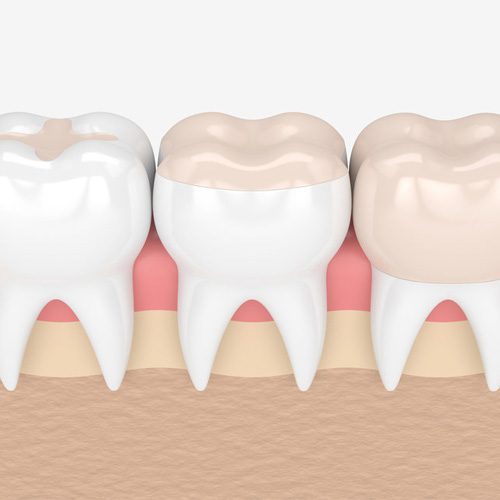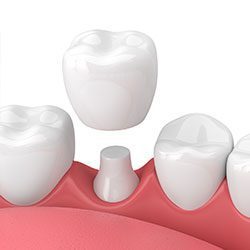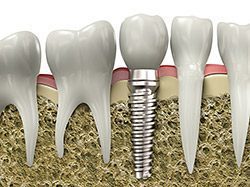Restorative Dentistry in Olympia, WA

During your first dental examination with x-rays, you will be given the opportunity to discuss your dental health and goals. What is important to you, is priority for us. You will be presented with options to meet your dental goals. We offer many different services. But, you will be invited to join the decision-making process of what dental treatment will work best for you. In partnership with YOUR dentist, you will have a healthy smile and know you were a part of the process. Leaving the dental office feeling confident and informed of your dental plan is our goal.
Dental bridges may be used to replace missing teeth, help maintain the shape of your face, and alleviate stress on your bite. A bridge replaces missing teeth with artificial teeth, looks great, and literally bridges the gap where one or more teeth may have been. Dental bridges are made up of two or more crowns for the teeth on either side of the gap — two or more anchoring teeth and a false tooth or teeth in between. Bridges can be made from gold, alloys, porcelain, or a combination of these materials, and is bonded onto surrounding teeth for support.
The success of any dental bridge depends two things. First is home care or maintaining proper oral hygiene. Second is the foundation it is built on— the other teeth, gums, or bone to which it is attached. Therefore, it’s very important to keep your existing teeth, gums, and jaw healthy and strong.

Even with a good oral care routine, sometimes small imperfections can find a way into your smile. However, if the idea of getting veneers is too much or teeth whitening doesn’t (or cannot) give you the results you’re looking for, dental bonding acts as a fantastic happy medium. Not only is treatment non-invasive and affordable, but the process is quick and painless. If you have small chips, cracks, stains, and even gaps in your smile, call our dental team today to set up your next appointment!
Many times, we hear from new patients that when they left other dental offices, they had more questions than answers. As a valued patient, every question and concern you have is important and each will be answered to your satisfaction.
Partial crowns, often referred to as onlay’s, are a type of dental restoration or porcelain filling that covers one or more cusps of your tooth. Onlay’s are also made of porcelain by a lab and take two appointments to complete. An inlay is like a dental filling, but the restoration is made of porcelain by a lab and is placed within the cusps on a tooth’s chewing surface. These restorations are much more conservative than crowns and can be imperceptible from your natural tooth. However, the use of onlays and inlays are limited to very specific situations and are not as common as a dental crown.
What Is Dental Bonding?
Dental bonding is a cosmetic procedure that utilizes composite resin material to restore teeth that have become cosmetically damaged in some way. The material is incredibly strong, even if it isn’t quite as durable as your natural enamel. However, it can be very easily color-matched so that it effectively blends in with your existing teeth without anyone being the wiser.
Dental bonding is actually quite similar to tooth-colored fillings in that they use the same material. The difference is tooth-colored fillings are used to restore teeth damaged by cavities (and usually replace the need for metal-colored fillings). Dental bonding is purely a cosmetic treatment and can be used on healthy teeth that have experienced normal wear and tear or minor issues.
Who Is a Good Candidate for Dental Bonding?
Candidates for dental bonding should not have any existing dental problems that should be addressed first (i.e. tooth decay, gum disease). If your smile is healthy, then you are likely a candidate for dental bonding if you have cosmetic concerns you’d like to handle. We often recommend dental bonding for the following imperfections:
- Chips
- Cracks
- Tough stains
- Small gaps
- Very small or malformed teeth
During your appointment, we’ll discuss your smile goals with you one-on-one in order to help you determine the best treatment for your needs. This may include dental bonding, another service, or a combination of the two.
The Dental Bonding Process
While the length of your treatment will vary depending on how many teeth you need to address, it takes anywhere between 30 and 60 minutes to treat a single tooth. We start by using a shade guide to select a composite resin material that matches your existing teeth as closely as possible. We’ll then etch a small area of your tooth so that a conditioning liquid can be applied. This makes the bonding material stick to the tooth more easily.
From there, the resin material is applied to your tooth, carefully molded, then smoothed to the desired shape. Once we’re finished shaping the resin, we can cure it using a special light that hardens within seconds. After making any final adjustments, we’ll polish the tooth so it shines just like your neighboring teeth.
The Benefits of Dental Bonding
You may not realize how much of an impact smile imperfections can have on your confidence until you’ve developed them. If you find yourself hiding your smile out of concern that others around you will notice them, dental bonding can be quite beneficial to your confidence and self-esteem day-to-day. You just may be surprised by how you feel when you’re able to express yourself to the fullest, whether you’re with friends, family members, coworkers, or people you’re meeting for the very first time.
What is a Dental Inlay?
An inlay is a lab fabricated porcelain filling that fits into the grooves of a tooth and do not extend over the cusps of tooth. The patient is numbed using a local anesthetic and the dentist drills the tooth to remove and clean out the decay in the tooth. This is one of the restorative methods used to repair a tooth after it sustains harm from injury or decay that does not affect the cusps of the tooth. The dentist takes an impression and sends it to a laboratory where the inlay is made.
Inlays are manufactured from porcelain or composite resin material matching the color of the tooth and provide almost invisible dental restoration while repairing the chewing surface. Dental inlays are generally more durable than regular fillings made from composite or amalgam.
What is a Dental Onlay?
Onlays also fit inside the tooth but extend onto the chewing surface of a back tooth to replace one or more cusps. In the past, onlays were made only of gold, but like inlays, more and more patients request a tooth-colored onlay. Making the onlay of ceramic/porcelain allows the restoration to be bonded to the tooth.
This bonding process may actually improve the strength of the tooth and help seal the onlay to the tooth. Sometimes It is difficult to determine when inlays or onlays can be used instead of crowns or caps. But, you are in great hands at Woodland Trails Dentistry as our dentists will review all your options with you to determine the best dental plan.

Dental fillings are normally composite materials that mimic the appearance of natural teeth. These materials come in a range of colors. The filling materials are used where a natural appearance is important. They are routinely used on front teeth and on the back teeth depending on the location and extent of the tooth decay.
What’s right for me?
Several factors influence the performance, durability, longevity and expense of dental restorations, including:
- The amount of tooth structure remaining
- Where and how the filling is placed
- The chewing load that the tooth will have to bear
- The components used in the filling material
- The length and number of visits needed to prepare and adjust the restored tooth
Before your treatment begins, our office will determine what materials will provide the best filling for your particular case. In preparation for this discussion it may be helpful to understand the two basic types of dental fillings — direct and indirect.
- Direct fillings are fillings placed into a prepared cavity in a single visit. They include silver amalgam, glass ionomers, resin ionomers, and composite (resin) fillings. The dentist and assistant prepare the tooth, place the filling, and adjusts it in one appointment.
- Indirect fillings generally require two or more visits. Crowns and veneers fabricated with ceramic material which match natural tooth color. In some instances, solid gold is used. Crowns are used when a tooth has too much damage to support a filling. During the first visit, the dentist prepares the tooth and makes an impression of the area to be restored. The assistant then places a temporary covering over the prepared tooth. The impression is sent to a dental laboratory, which creates the dental restoration. At the next appointment, the dentist cements the restoration into the prepared cavity and adjusts it as needed.

Crowns are a restorative procedure used to improve your tooth’s shape or to strengthen a tooth. Crowns are most often used for teeth that are broken, worn, or have portions destroyed by tooth decay.
A crown is a “cap” cemented onto an existing tooth that usually covers the portion of your tooth above the gum line. In effect, the crown becomes your tooth’s new outer surface. Crowns can be made of porcelain, metal, or both. Porcelain crowns are most often preferred because they mimic the translucency of natural teeth and are very strong.
Crowns or onlays (partial crowns) are needed when there is insufficient tooth strength remaining to hold a filling. Unlike fillings, which apply the restorative material directly into your mouth, a crown is fabricated away from your mouth. Your crown is created in a lab from your unique tooth impression, which allows a dental laboratory technician to examine all aspects of your bite and jaw movements. Your crown is then sculpted just for you so that your bite and jaw movements function normally once the crown is placed.

If you are missing teeth, it is crucial to replace them. Without all your teeth, chewing and eating can destabilize your bite and cause you discomfort. When teeth are missing, your mouth can shift and even cause your face to look older. Implants are a great way to replace your missing teeth, and if properly maintained, can last a lifetime!
An implant is a new tooth made of metal and porcelain that looks just like your natural tooth. It’s composed of two main parts: one part is the titanium implant body that takes the place of the missing root, and the second part is the tooth-colored crown that is cemented on top of the implant. With implant treatment, you can smile confidently knowing no one will ever suspect you have a replacement tooth.
In addition to tooth replacement, implants may be used to anchor dentures, especially lower dentures that tend to shift when you talk or chew. For patients with removable partial dentures, implants can replace missing teeth so you have a more natural-looking smile.

Dentures are natural-looking replacement teeth that are removable. There are two types of dentures: full and partial. Full dentures are given to patients when all of the natural teeth have been removed. Partial dentures are attached to a metal frame that is connected to your natural teeth and are used to fill in where permanent teeth have been removed. Just like natural teeth, dentures need to be properly cared for. Use a gentle cleanser to brush your dentures, always keep them moist when they’re not in use, and be sure to keep your tongue and gums clean as well.
The first line of defense against gum disease is a unique type of cleaning called “scaling and root planing.” In this procedure, an ultrasonic cleaning device is used to remove plaque and tartar from your teeth where regular cleaning devices can’t reach: under the gum line, on the tooth, and around the root. Then, the rough surface of the tooth and the root are smoothed out (planed). This provides a healthy, clean surface that makes it easier for the gum tissue to reattach to the tooth.
If you address your gum disease before it becomes severe, scaling and root planing may be the only treatment you need. However, as with any dental procedure, after-care is vital. In order to keep your teeth in good shape and resist future occurrences of gum disease, you must brush and floss daily, eat a healthy diet, avoid tobacco use, and have regular dental checkups. Even after a successful scaling and root planing, if you don’t attend to your teeth properly, it’s quite likely that you’ll develop gum disease again.
If the tissue or bone surrounding your teeth is too damaged to be repaired with non-surgical treatment, several surgical procedures are available to prevent severe damage and to restore a healthy smile. We will recommend the procedure that is best suited to the condition of your teeth and gums. Following is a list of common types of periodontal surgery:
- Pocket Depth Reduction
In a healthy mouth, the teeth are firmly surrounded by gum tissue and securely supported by the bones of the jaw. Periodontal disease damages these tissues and bones, leaving open spaces around the teeth that we call pockets. The larger these pockets are, the easier it is for bacteria to collect inside them, leading to more and more damage over time. Eventually the supportive structure degrades to the point that the tooth either falls out or needs to be removed.During pocket reduction procedures (also known as “flap surgery”), we fold back the gum tissue and remove the bacteria hiding underneath, as well as the hardened plaque and tartar that have collected. We may also remove any tissue that is too damaged to survive. We then sew the healthy tissue back into place. Now that the tooth and root are free of bacteria, plaque, and tartar, and the pockets have been reduced, the gums can reattach to the teeth. - Regeneration
When the bone and tissue supporting the teeth have been lost due to severe gum disease, we can restore these areas with a regeneration procedure. During this process, we begin by folding back the gum tissue and removing the bacteria, plaque, and tartar. Depending on your situation, we may then perform a bone graft to stimulate new bone growth, or we may apply a special kind of protein that stimulates tissue growth to repair the areas that have been destroyed by the disease. - Soft-Tissue Graft
A frequent symptom of gum disease is gum recession (also called gingival recession). As the gums recede, more of the roots are revealed. This can make teeth appear longer and can also create sensitivity to hot or cold liquids or food. It also exposes the tooth to increased damage from gum disease, as bacteria, plaque, and tartar attack the surface of the tooth and the root.During a soft-tissue graft, tissue from the top of your mouth or another source is sewed to the gum area, covering the roots and restoring the gum line to its original, healthy location. This procedure can also be performed for cosmetic reasons.
